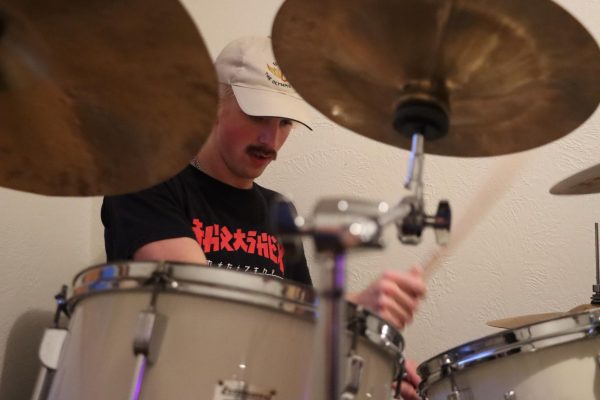A game for nostalgia seekers: ‘Super Smash Bros. Ultimate’
January 16, 2019
Just this last year, we were introduced to one of the “most ambitious crossovers” in entertainment history. Heroes versus villains, heroes versus heroes, villains versus villains, and one big baddie to rule them all. With a recognizable cast of characters, this had to be the most hyped-up media release of the year. I’m sure you all know exactly what I’m talking about: “Super Smash Bros. Ultimate” for the Nintendo Switch. (Sorry to tease you, Marvel fans.)
There is nary a soul who doesn’t recognize the title of one of Nintendo’s most famous game series. Starting on the Nintendo 64 in 1999, franchise creator Masahiro Sakurai had created a very nontraditional fighting game. Fighting games were designed with common elements: Two fighters that filled up most of the screen moved on a 2D plane (save for some outliers) on a limited, flat stage with the main goal to deplete each other’s health bars through attacks and combos. Sounds pretty basic enough, right? Hit until dead. This basic premise could be seen in “Street Fighter,” “Mortal Kombat,” “Killer Instinct,” and “King of Fighters.”
“Super Smash Bros.” decided to switch things up a bit; for one, Sakurai decided to do away with the whole health depletion system and went with a new approach: knock your opponent out of the ring. The entire stage you play on is suspended, and the way to beat your opponent is rack up enough damage to them to send them flying off screen, giving you a point. Instead of health bars, damage percentage stats are shown on the bottom of your screen, next to your score. The higher the damage, the easier it is to launch your opponent farther. The characters are smaller on the screen to allow more freedom of movement, along with the capability to play larger, more complex stages. Along with all of that, there’s a slew of items from various Nintendo games you can use to your advantage.
With the basic premise out of the way, let’s get into the meat and potatoes of “Super Smash Bros” history. The cast of characters is, honestly, some of the biggest attractions to this game. Considering the technological capabilities of the Nintendo 64, the roster of the first game was limited but included the essentials: Mario, Link, Donkey Kong, Samus, Pikachu, Fox, Yoshi, and Kirby. All of these easily recognizable characters, along with a few other hidden unlockable characters, provided a great crew for a fun action fighting game.
The series had a few releases that lead up to “Ultimate,” the game at hand. The first sequel, “Super Smash Bros. Melee” for the Nintendo Gamecube, added not only more characters and items, but more moves to build combos and special modes for unique means of playing the game.
The next game to come out was “Super Smash Bros. Brawl” for the Wii, which added a cooperative story mode about the characters being transformed into trophies. “Brawl” was an especially exciting release. It was the first game in the series that brought in third-party characters; Solid Snake from the “Metal Gear” series, and Sonic the Hedgehog from the (aptly-named) “Sonic the Hedgehog” series. It also was the first “Smash” game to allow online multiplayer gameplay (However, Nintendo is not known for their strong online multiplayer service and the series is typically better recognized for its strong local multiplayer gameplay anyway).
After “Brawl,” Nintendo went a little more straightforward on the name of the next game in the series: “Super Smash Bros. for the Nintendo 3DS and Wii U” for the (surprise!) Nintendo 3DS and Wii U. If that proves to be too much of a mouthful, you can just call it “Smash 4.” This game was, more or less, an improvement on graphics and an allowance of more characters. There wasn’t a whole lot of change in this game, but it is special in a few ways: it was one of the first “Smash” games to have a mainstream competitive community, the first “Smash” game to have DLC, allowed the use of Miis (Nintendo’s take on avatar creation) within the game and was subject to the community’s ire for supposedly having too many similar “anime swordsman,” referring to the increased number of “Fire Emblem” characters in that iteration.
Finally, the latest release of the series: “Super Smash Bros. Ultimate” for the Nintendo Switch. Why is this game the “Ultimate” of the series? Because it includes every single character included in the series’ history. Some of the characters have disappeared from the roster in the assemblance of the series, but not in this game. Everyone is here. Every character that has been in the series at any point is playable, along with some other fun surprises. The long awaited “Metroid” villain, Ridley, makes his debut appearance in “Ultimate”, along with the crockety King K.Rool from the “Donkey Kong” series. All in all, “Super Smash Bros. Ultimate” boasts 76 different characters to choose from (This isn’t to mention five promised DLC characters and the pre-order bonus character).
Along with the regular sequel enhancements, like graphics and slight character changes, “Ultimate” offers a new single-player mode called “World of Light”, which isn’t unlike that of “Brawl’s story mode experience. Along with that is the Spirit mode. Through completing specific battles, you can unlock special non playable characters that will enhance your main fighter.
Ok, time to review. I’ve played all five of these games, so I have a taste of each game. Let me start off with this: the game is fun. The movement and tangible grasp of this game is very entertaining. I’ve had fun with this game all by myself, despite being at its best when playing with friends; sometimes it’s just fun to wail on some easy computer characters instead of always getting beat down by your friends. The graphics are absolutely wonderful with its vibrant colors and vast atmospheres within the different stages you can choose. With a collaboration this big, there’s a ridiculously big track list for you to listen to: 850 different songs. The most exciting part of this game, however, is the character selection (in case me telling you that 20 times already wasn’t enough). Each character is different and unique (save for Echo fighters, which are slight variations on already existing characters) and remain faithful to their original game with references and moves that harkon back to the source. There are so many different characters, you will be hard pressed to find someone you won’t recognize. Seriously; if you play this game, you will find a character you will like. Do you enjoy playing the neutral, all-around character? Bam, you can play Mario and Mii Fighters. Do you like technical characters that requires training? Bam, Bayonetta and PAC-MAN. Do you like big hulky characters that land super satisfying hits? Bam, Bowser and Donkey Kong. Do you like anime swordsman that have counter-attacks? Smash has tons of ‘em! Point is, everyone have a character they can jibe with.
Let me help you decide whether or not if you want this game. If you enjoy a game that is: easy to play with everyone, pick-up and put-down, plentiful with characters and couch co-op friendly, go for it. However, if you: don’t have a Nintendo Switch, prefer a much more technical and in-depth fighting game, aren’t in the mood to drop $60 or aren’t particularly fond of Nintendo as a company, then maybe pick something else.
This game series was deeply imbedded into my childhood and I’ve played every single game that has come out of the series. Honestly, this game’s announcement was the push for me to buy the Switch in the first place! In the month that I’ve had it so far, it’s definitely seen its use. High recommendation.










